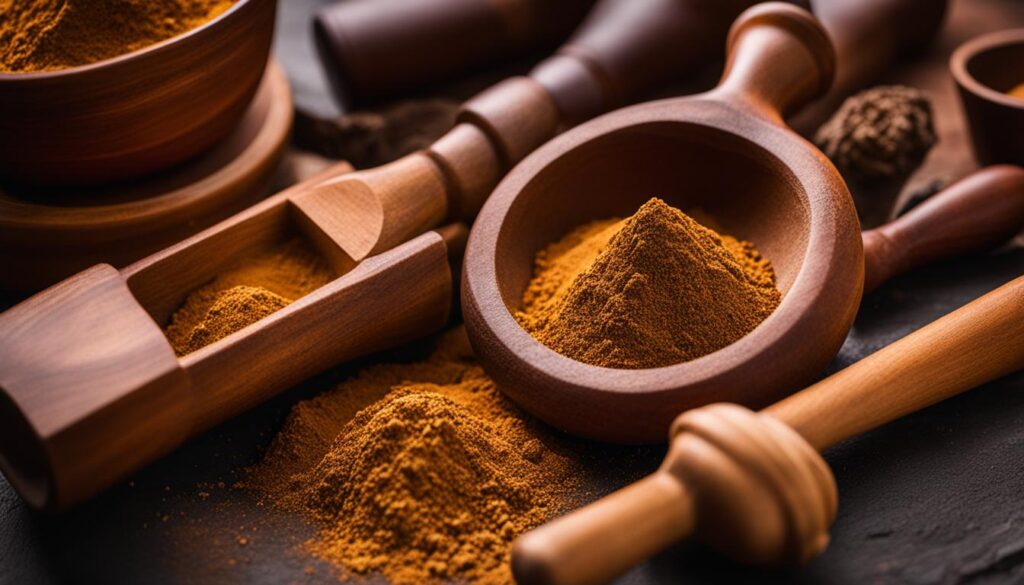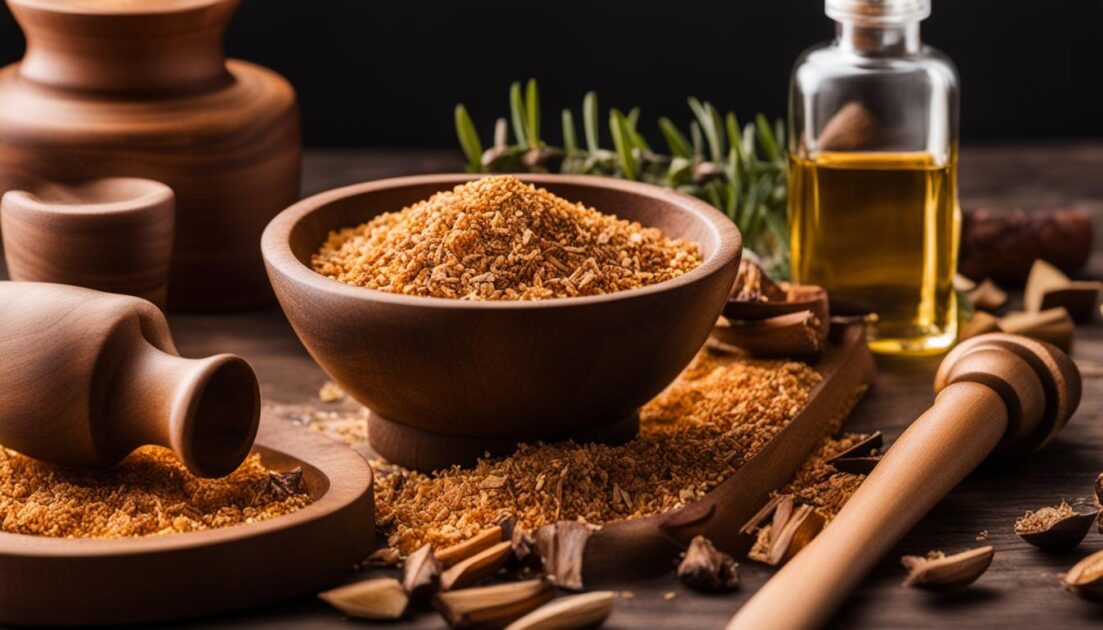Sandalwood oil has been prized for centuries for its unique fragrance and therapeutic properties. If you’re interested in making your own sandalwood oil at home, you’ve come to the right place. In this DIY guide, I’ll walk you through the process of extracting sandalwood oil from chips or powder, allowing you to enjoy the benefits of this aromatic oil right in the comfort of your own home.
Key Takeaways:
- By making your own sandalwood oil at home, you can ensure its quality and purity.
- Homemade sandalwood oil may be free of synthetic fragrances found in store-bought versions.
- Sandalwood oil offers numerous benefits like soothing properties, reducing inflammation, and improving mental clarity.
- The process involves crushing sandalwood chips or powder, infusing them in a carrier oil, and straining out the oil.
- Homemade sandalwood oil can be used in various ways, such as adding it to body lotions or diffusing it in a room.
The Benefits of Sandalwood Oil
Sandalwood oil offers numerous benefits and has been used for centuries in traditional medicine and aromatherapy practices. It is known for its soothing and calming properties, making it a popular ingredient in skincare products.
“Sandalwood oil has been used for centuries in traditional medicine and aromatherapy practices.”
One of the key benefits of sandalwood oil is its ability to reduce inflammation. It contains compounds that help to soothe irritated skin and reduce redness. This makes it an excellent choice for individuals with sensitive or acne-prone skin.
“Sandalwood oil helps to reduce inflammation and soothe irritated skin.”
In addition, sandalwood oil is known for its relaxing properties. It can help calm the mind and alleviate stress and anxiety. This makes it a popular choice for use in meditation and relaxation practices.
“Sandalwood oil has relaxing properties that can help calm the mind and alleviate stress.”
Furthermore, sandalwood oil is believed to improve mental clarity and promote a sense of focus and concentration. It has a grounding effect on the mind, making it beneficial for individuals who struggle with mental fatigue or lack of concentration.
“Sandalwood oil improves mental clarity and promotes focus and concentration.”
Another notable benefit of sandalwood oil is its antimicrobial properties. It has been found to possess natural antibacterial and antifungal properties, making it useful for treating acne and other skin conditions caused by bacteria and fungi.
“Sandalwood oil has antimicrobial properties that can help in the treatment of acne and other skin conditions.”
Besides its therapeutic properties, sandalwood oil also emits a unique and pleasant fragrance. Its rich, woody aroma makes it a popular choice for perfumes and aromatherapy blends.
“Sandalwood oil has a unique and pleasant fragrance, making it popular in perfumes and aromatherapy.”
In summary, the benefits of sandalwood oil are extensive. It offers soothing and calming effects, reduces inflammation, improves mental clarity, has antimicrobial properties, and emits a pleasant fragrance. Incorporating sandalwood oil into your skincare routine or aromatherapy practices can enhance your well-being and promote a sense of relaxation and rejuvenation.

The Process of Making Sandalwood Oil
The process of making sandalwood oil involves the extraction of the essential oil from sandalwood chips or powder. Let me guide you through the steps of this fascinating process.
Gather Ingredients and Equipment
First, gather all the necessary ingredients and equipment:
- Sandalwood chips or powder
- Mortar and pestle for crushing the sandalwood
- Carrier oil, such as olive oil
- Glass jar for storing the oil
- Sieve or cheesecloth for straining
Crush and Infuse
Start by crushing the sandalwood chips or powder using a mortar and pestle. This step helps release the aromatic compounds from the sandalwood.
Next, mix the crushed sandalwood with the carrier oil in a glass jar. Ensure that the sandalwood is fully submerged in the oil. Close the jar tightly and gently shake it to combine the ingredients.
Place the jar in a cool, dark place and allow the mixture to infuse for several days. This infusion period allows the oil to absorb the rich fragrance and beneficial properties of the sandalwood.
Strain and Store
After the infusion period, strain the mixture using a sieve or cheesecloth to remove any solid particles. The result is pure sandalwood oil.
Transfer the strained oil into a clean glass jar for storage. It’s important to store the oil in a cool, dark place to maintain its potency.

Complete Table: Comparison of Homemade Sandalwood Oil and Store-Bought Versions
| Aspects | Homemade Sandalwood Oil | Store-Bought Sandalwood Oil |
|---|---|---|
| Quality | Dependent on the quality of sandalwood used | Varies depending on the brand and production process |
| Purity | Can be ensured by using high-quality ingredients | May contain synthetic fragrances or additives |
| Fragrance | Authentic and natural scent from quality sandalwood | May contain synthetic fragrances to enhance the scent |
| Cost | More cost-effective in the long run | Varies depending on the brand |
| Control | Ability to control the quality and potency of the oil | Dependent on the brand’s production standards |
By making your own sandalwood oil, you have the opportunity to create a high-quality and authentic product that meets your specific preferences and needs. Experiment with different types of sandalwood and carrier oils to personalize your homemade creation.
Using Sandalwood Oil at Home
Sandalwood oil offers a wide range of applications that can enhance your daily routine. Here are some popular ways to incorporate sandalwood oil into your home:
- Add to Body Lotion: Enhance the fragrance and benefits of your body lotion by adding a few drops of sandalwood oil. This not only adds a pleasing aroma but also provides additional nourishment and moisturization for your skin.
- Enjoy Aromatic Baths: Transform your bath into a luxurious and aromatic experience by adding sandalwood oil to your bathwater. The relaxing scent can help you unwind, reduce stress, and promote a sense of well-being.
- Apply as a Skin Moisturizer: Dilute sandalwood oil in a carrier oil, such as coconut oil or almond oil, and use it as a moisturizer for your skin. This can help hydrate and nourish your skin, leaving it feeling soft and supple. Additionally, the calming properties of sandalwood oil can provide a soothing effect.
- Create a Relaxing Atmosphere: Diffuse sandalwood oil in a room to create a pleasant and calming ambiance. The sweet and woody aroma of sandalwood can promote relaxation, reduce anxiety, and improve sleep quality.
These are just a few examples of how sandalwood oil can be incorporated into your daily life. Get creative and explore different ways to enjoy the soothing properties and captivating fragrance of sandalwood.

“Sandalwood oil offers a multitude of benefits and can be used in various ways. By incorporating sandalwood oil into your skincare routine, baths, and diffusers, you can experience its exquisite fragrance and therapeutic effects.”
Tips and Precautions for Making Sandalwood Oil
When making homemade sandalwood oil, it’s important to follow certain tips and precautions to ensure the best results and maintain safety. Here are some key considerations:
- Use high-quality sandalwood: To achieve a potent and fragrant oil, it’s crucial to use high-quality sandalwood chips or powder. Look for aged sandalwood, as older wood tends to produce better oil and scent.
- Perform a patch test: Before using the oil on your skin, it’s recommended to perform a patch test. Apply a small amount of the homemade sandalwood oil onto a small area of your skin and wait for 24 hours. If there are no adverse reactions such as redness, itching, or irritation, it’s generally safe to use the oil.
- Store properly: To preserve the potency of your homemade sandalwood oil, store it in a glass jar in a cool, dark place. Exposure to heat, light, and air can degrade the oil over time, so it’s important to protect it from these elements.
Keep in mind that homemade sandalwood oil may not be as potent as store-bought versions, but it can still offer therapeutic benefits when used properly. By following these tips and precautions, you can create your own high-quality sandalwood oil and enjoy its soothing properties.
Conclusion
Making sandalwood oil at home is a rewarding and cost-effective way to enjoy the benefits of this aromatic oil. By following the step-by-step guide and taking necessary precautions, you can create your own high-quality sandalwood oil that rivals store-bought versions.
Explore the various uses of sandalwood oil, from enhancing skincare products to creating a relaxing atmosphere through diffusion. Incorporate it into your daily routine for its soothing and therapeutic properties.
Enjoy the process of creating your own homemade sandalwood oil and experience the joy of using a product that you made with your own hands. So why wait? Start your DIY sandalwood oil journey today!
FAQ
How do I make sandalwood oil at home?
To make sandalwood oil at home, you will need sandalwood chips or powder and a carrier oil. Crush the sandalwood chips or powder using a mortar and pestle, then mix it with the carrier oil and allow it to infuse for several days. Strain the mixture to remove any solid particles, and store the oil in a glass jar in a cool, dark place.
What are the benefits of sandalwood oil?
Sandalwood oil offers numerous benefits, including its soothing and calming properties. It can reduce inflammation, promote relaxation, improve mental clarity, and has antimicrobial properties. It is also used in skincare products for its ability to treat acne and other skin conditions.
How is sandalwood oil made?
Sandalwood oil is made by extracting the essential oil from sandalwood chips or powder. The process involves crushing the chips or powder, mixing them with a carrier oil, and allowing the mixture to infuse. Afterward, the mixture is strained to remove any solid particles, leaving behind the pure sandalwood oil.
How can I use sandalwood oil at home?
Sandalwood oil can be added to body lotion, bathwater, or diluted in a carrier oil and applied to the skin. It can also be diffused in a room for a pleasant and relaxing fragrance.
Are there any precautions when making sandalwood oil?
When making homemade sandalwood oil, it’s important to use high-quality sandalwood chips or powder for the best results. Perform a patch test before using the oil to check for any potential allergic reactions. Store the homemade oil in a glass jar in a cool, dark place to preserve its potency.
Why should I make my own sandalwood oil?
Making your own sandalwood oil allows you to control the quality and purity of the oil, ensuring a potent and authentic product. Homemade sandalwood oil may also be free of synthetic fragrances that are often present in store-bought versions.






